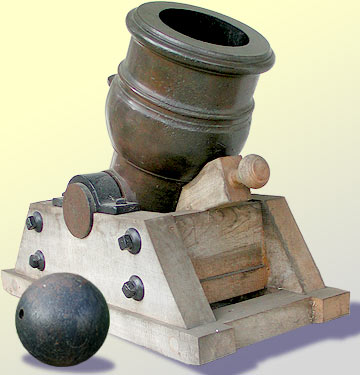 |
Up and Over: Mortars |
The very walls that made the artillery fort what it was also served well to protect the buildings it enclosed against cannon fire. Cannons with their trajectories in near straight lines or shallow arcs could not drop a cannonball precisely over a wall and into the enclosed area.

Note the fuse hole at the left in the mortar round.
The mortar changed that to make any set of buildings behind fort walls vulnerable - very vulnerable. The mortar, with an arc higher than long for its trajectory, simply lobbed its rounds over the walls. As cannon chewed up the walls, their companion mortars pulped the fort's interior.
The Spanish introduced the mortar in 1588 at the siege of Wacthendonck in the Lowlands. But the Spanish did not exploit the advantage of this lobbing weapon and came to the conclusion, proved misguided, that it was a weapon for the defense. On the contrary, it became a prime tool for attackers because they could concentrate the fire of several mortars into one small area (whereas those inside the fort had to scatter their mortar fire at diverse targets way outside the walls).
That was not all!!!
The mortar added a second and very devastating feature to bombardment. Conceived by a Thomas Malthus* in 1634, the shells it lobbed could literally be that: shells of iron around a core of gunpowder. Not only did mortar shells drop into buildings within the fort, they exploded upon arrival. Imagine a heavy sphere about 30 centimeters in diameter crashing down through the roof and top floor and perhaps all the way to the ground floor - then exploding. At the very least, the interior was gutted, more likely, the structure collapsed or caught fire. So effective was the exploding mortar shell that some fort defenders capitulated, not after the first cannon shots were fired, but when mortar rounds began to fall inside.
This devastating feature posed a risk for attackers, though. It was very tricky to have everything go as intended. The mortar round, packed with powder, had only a fuse hole into which was inserted a slow-burning fuse. That fuse was lit manually by the gunner immediately before discharging the mortar itself. If the mortar misfired, then the mortar crew had, to put it mildly, an urgent emergency. Presumably a fast toss of a bucket of water might put out that fuse. But if that didn't work, or if no one had the presence of mind, the next few seconds could get, um, messy. Even if the mortar fired as anticipated/hoped, should the fuse have been too short or burned too fast, the shell simply made a harmless flash above the fort; if the fuse was too long or burned too slow, the shell could bury itself into the ground or below a house with much of the explosive force absorbed by the earth.
*Not the Thomas Malthus of population-growth-curve fame. That Malthus came a century later.